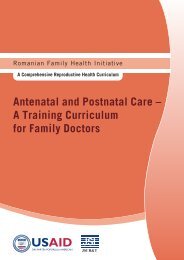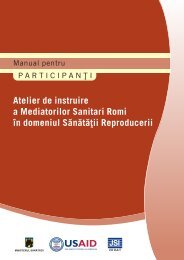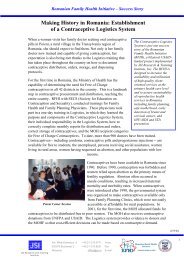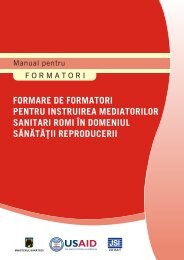Training of Roma Health Mediators in Reproductive Health
Training of Roma Health Mediators in Reproductive Health
Training of Roma Health Mediators in Reproductive Health
You also want an ePaper? Increase the reach of your titles
YUMPU automatically turns print PDFs into web optimized ePapers that Google loves.
Some women have very large areolas, so you may not see a lot <strong>of</strong> areola outside the<br />
baby’s mouth even though he is well attached. Compare how much areola you can see<br />
above and below the baby’s mouth. When the baby is well attached, you will see more<br />
areola above his mouth than below it.<br />
There are 4 po<strong>in</strong>ts <strong>of</strong> good attachment. The baby’s:<br />
1. Ch<strong>in</strong> is close to the breast<br />
2. Mouth is wide open<br />
3. Lower lip is turned outwards<br />
4. Mouth is beyond the nipple and attached to the areola. (More areola will be<br />
noted above than below the mouth).<br />
Post the flipchart/project the overhead Baby’s Attachment to the Breast.<br />
Ask participants:<br />
‣ What signs <strong>of</strong> good attachment do you see?<br />
• The baby's ch<strong>in</strong> is touch<strong>in</strong>g the breast.<br />
• His mouth is wide open.<br />
• His lower lip is turned outwards.<br />
• His cheeks are round, or flattened, aga<strong>in</strong>st his mother's breast.<br />
• There is more areola above the baby's mouth than below it.<br />
• The breast looks rounded dur<strong>in</strong>g a feed.<br />
‣ How can you tell if a baby is suckl<strong>in</strong>g effectively?<br />
• The baby is tak<strong>in</strong>g slow deep sucks.<br />
• His sucks become deeper and slower (after the few quick sucks at the beg<strong>in</strong>n<strong>in</strong>g <strong>of</strong><br />
the feed)<br />
• You can see and/or hear the baby swallow<strong>in</strong>g.<br />
• The baby gulps as he swallows. Gulps are very loud swallow<strong>in</strong>g sounds, when a lot<br />
<strong>of</strong> fluid is be<strong>in</strong>g swallowed at once. This is a sign that a baby is gett<strong>in</strong>g a lot <strong>of</strong><br />
milk. It sometimes means that his mother has an oversupply, and her baby is gett<strong>in</strong>g<br />
too much milk too fast. Oversupply is sometimes the cause <strong>of</strong> breastfeed<strong>in</strong>g<br />
difficulties.<br />
‣ What signs <strong>of</strong> poor attachment do you see?<br />
• The baby's ch<strong>in</strong> is not touch<strong>in</strong>g the breast<br />
• His mouth is not wide open (especially important with a large breast).<br />
• His lips are po<strong>in</strong>t<strong>in</strong>g forwards (his lower lip is turned <strong>in</strong>).<br />
• His cheeks are tense or pulled <strong>in</strong> as he suckles.<br />
• There is more areola below the baby's mouth than above it, or the same amount<br />
above and below.<br />
• The breast looks stretched or pulled dur<strong>in</strong>g a feed.<br />
147<br />
RFHI/JSI <strong>Roma</strong>nia <strong>Tra<strong>in</strong><strong>in</strong>g</strong> <strong>of</strong> RHMs <strong>in</strong> <strong>Reproductive</strong> <strong>Health</strong> Session 9: Breastfeed<strong>in</strong>g








